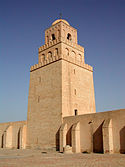Mohammed al-Tawudi ibn Suda | |
|---|---|
| Personal | |
| Born | 1700 |
| Died | 1795 |
| Religion | Islam |
| Denomination | Sunni |
| Creed | Maliki |
| Main interest(s) | Islamic jurisprudence, Hadith, Sufism |
| Notable work(s) | Commentary on Sahih al-Bukhari |
| Alma mater | Al-Azhar University |
| Occupation | Scholar, Mufti, Shaykh al-Jamaa |
| Senior posting | |
Influenced by | |
Influenced | |
| Moroccan literature |
|---|
| Moroccan writers |
| Forms |
| Criticism and awards |
| See also |
Mohammed ibn al-Talib al-Tawudi ibn Suda (Arabic: محمد التاودي بن سودة; 1700–1795) was one of the most influential scholars of the 18th century in Morocco, both politically and intellectually. He is described by the Egyptian historian, Al-Jabarti, as the "crescent of the Maghrib".[1] He went on the hajj in 1767-1768 and studied in Medina with Mohammed ibn Abdel Karim al-Samman (1718–1775), founder of the Sammaniyya branch[2] of the Khalwatiyya and in Cairo with the Indian scholar Mohammed Murtada al-Zabidi (d. 1791). In Cairo he also taught the Muwatta of Malik ibn Anas at the Al-Azhar. Ibn Suda was appointed by the sultan in 1788 to reform the curriculum at the Qarawiyin University of Fez, where he was installed as mufti and shaykh al-jamaa. Ibn Suda is also well known as the author of a commentary on Sahih al-Bukhari[3] and as the teacher of Ahmed ibn Idris.
See also
[edit]References
[edit]- ^ Rex S. O'Fahey, Enigmatic saint: Ahmad ibn Idris and the Idrisi tradition, London, 1990, p. 35-36
- ^ it:Sammaniyya
- ^ See: Abd al-Hayy ibn Abd al-Kabir al-Kattani, Fihris al-faharis wa'l-athbat wa-mu'jam al-ma'ajim wa'l-mashyakhat wa'l-musalsalat, ed. Ihsan Abbas, 3 vols., Beirut 1982-6, pp. 256-63,

Well, that’s interesting to know that Psilotum nudum are known as whisk ferns. Psilotum nudum is the commoner species of the two. While the P. flaccidum is a rare species and is found in the tropical islands. Both the species are usually epiphytic in habit and grow upon tree ferns. These species may also be terrestrial and grow in humus or in the crevices of the rocks.
View the detailed Guide of Psilotum nudum: Detailed Study Of Psilotum Nudum (Whisk Fern), Classification, Anatomy, Reproduction